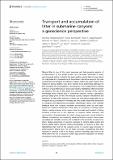Por favor, use este identificador para citar o enlazar a este item:
http://hdl.handle.net/10261/336362COMPARTIR / EXPORTAR:
 SHARE SHARE
 CORE
BASE CORE
BASE
|
|
| Visualizar otros formatos: MARC | Dublin Core | RDF | ORE | MODS | METS | DIDL | DATACITE | |

| Título: | Transport and accumulation of litter in submarine canyons: a geoscience perspective |
Autor: | Pierdomenico, Martina; Bernhardt, Anne; Eggenhuisen, Joris T.; Clare, Michael A.; Lo Iacono, Claudio CSIC ORCID; Casalbore, Daniele; Davies, Jaime S.; Kane, Ian; Huvenne, Veerle A.I.; Harris, Peter T. | Palabras clave: | Submarine canyons Marine litter Microplastics Fishing-related debris Litter transport Sediment transport Deep-sea litter |
Fecha de publicación: | jul-2023 | Editor: | Frontiers Media | Citación: | Frontiers in Marine Science 10: 1224859 (2023) | Resumen: | Marine litter is one of the most pervasive and fast-growing aspects of contamination in the global ocean, and has been observed in every environmental setting, including the deep seafloor where little is known about the magnitude and consequences of the problem. Submarine canyons, the main conduits for the transport of sediment, organic matter and water masses from shallow to abyssal depths, have been claimed to be preferential pathways for litter transport and accumulation in the deep sea. This is supported by ongoing evidence of large litter piles at great water depths, highlighting efficient transfer via canyons. The aim of this article is to present an overview of the current knowledge about marine litter in submarine canyons, taking a geological, process-based point of view. We evaluate sources, transport mechanisms and deposition of litter within canyons to assess the main factors responsible for its transport and accumulation in the deep sea. Few studies relate litter distribution to transport and depositional processes; nevertheless, results from available literature show that canyons represent accumulation areas for both land-based and maritime-based litter. Particularly, accumulation of fishing-related debris is mainly observed at the canyon heads and walls and is related to fishing activities carried out in and adjacent to canyons, while transport and accumulation of general waste and plastic along canyon axes can be related to different mechanisms, encompassing enhanced bottom currents, dense water cascading and turbidity currents, and is related to the proximity of canyons to shore. Global assessment of canyons exposure to riverine plastic inputs and fishing-related debris indicates varying susceptibility of canyons to litter, also highlighting that most of the canyons prone to receive large amounts of anthropogenic debris have not yet been surveyed. Considering that litter research in canyons is still in its infancy, several knowledge gaps need to be filled before the role of canyons as litter traps and the implication for benthic ecosystems can be fully understood | Descripción: | 22 pages, 10 figures, supplementary material https://www.frontiersin.org/articles/10.3389/fmars.2023.1224859/full#supplementary-material | Versión del editor: | https://doi.org/10.3389/fmars.2023.1224859 | URI: | http://hdl.handle.net/10261/336362 | DOI: | 10.3389/fmars.2023.1224859 | E-ISSN: | 2296-7745 |
| Aparece en las colecciones: | (ICM) Artículos |
Ficheros en este ítem:
| Fichero | Descripción | Tamaño | Formato | |
|---|---|---|---|---|
| Pierdomenico_et_al_2023.pdf | 28,19 MB | Adobe PDF |  Visualizar/Abrir | |
| Pierdomenico_et_al_2023_suppl_table_1.XLSX | 26,04 kB | Microsoft Excel XML | Visualizar/Abrir | |
| Pierdomenico_et_al_2023_suppl_table_2.DOCX | 13,3 kB | Microsoft Word XML | Visualizar/Abrir | |
| Pierdomenico_et_al_2023_suppl_table_3.DOCX | 616,61 kB | Microsoft Word XML | Visualizar/Abrir | |
| Pierdomenico_et_al_2023_suppl_table_4.DOCX | 14,29 kB | Microsoft Word XML | Visualizar/Abrir |
CORE Recommender
SCOPUSTM
Citations
3
checked on 26-abr-2024
WEB OF SCIENCETM
Citations
2
checked on 22-feb-2024
Page view(s)
87
checked on 27-abr-2024
Download(s)
24
checked on 27-abr-2024
Google ScholarTM
Check
Altmetric
Altmetric
Este item está licenciado bajo una Licencia Creative Commons

